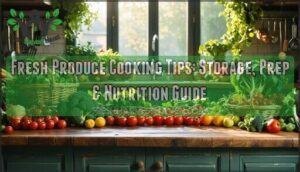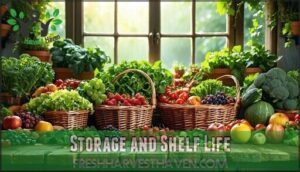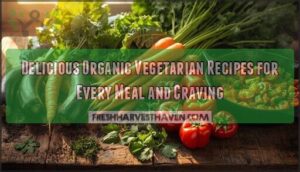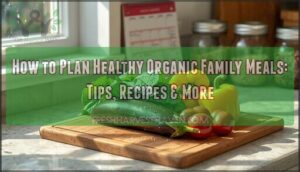This site is supported by our readers. We may earn a commission, at no cost to you, if you purchase through links.

The culprit isn’t just forgetfulness. It’s a lack of know-how about cooking methods that preserve flavor, storage tricks that extend shelf life, and prep strategies that turn good intentions into actual meals.
Master a few fresh produce cooking tips, and you’ll transform those farmers market hauls into dishes that taste fantastic and keep your fridge from becoming a compost bin. Your produce deserves better than the trash, and your wallet will thank you.
Table Of Contents
- Key Takeaways
- Cooking Fresh Produce
- Preparation Efficiency Tips
- Nutritional Considerations Matter
- Common Cooking Mistakes
- Storage and Shelf Life
- Frequently Asked Questions (FAQs)
- How do you prepare fresh produce?
- How do I eat a lot of fresh produce?
- What is my fresh approach to cooking?
- How do I choose the best fresh produce?
- How do you keep produce fresh?
- How do I get the most nutrition from my produce?
- What is a fresh produce guide?
- Why should you cook with seasonal produce?
- How do you make a good grocery store?
- What are the best places to buy fresh produce?
- Conclusion
Key Takeaways
- Roasting at 400°F brings out natural sweetness through caramelization, while steaming preserves crunch and locks in up to 91% of vitamin C, making your cooking method choice as important as the produce itself.
- Americans waste nearly 40% of fresh produce at home, but simple storage fixes like separating ethylene-producing fruits from leafy greens and controlling crisper humidity can extend shelf life by weeks.
- Quick Sunday prep sessions—washing, chopping, and storing vegetables in clear containers—transform meal planning from daily stress into efficient weeknight cooking that actually uses what you bought.
- One tablespoon of excess oil adds 120 hidden calories to your healthy vegetables, so measuring portions and choosing steaming or sautéing with minimal fat keeps nutrition goals on track without sacrificing flavor.
Cooking Fresh Produce
The way you cook fresh produce can make or break its flavor and texture. Different cooking methods bring out unique qualities—some add sweetness, others preserve crunch, and a few intensify natural sugars.
Here’s how to match your technique to what’s on your cutting board.
Roasting Vegetables for Natural Sweetness
Toss your vegetables with a little oil and watch them turn golden in a hot oven—that’s when the real magic happens. Roasting at a temperature around 400°F triggers vegetable caramelization, releasing the natural sweetness from seasonal cooking favorites.
Here’s what makes oven roasting techniques work:
- Root vegetables like carrots and beets develop concentrated roasted flavor enhancement
- Uniform cuts guarantee even cooking and consistent texture
- Fresh produce needs space on the pan—crowding prevents browning
What you end up with are vegetables so flavorful they’ll actually disappear from the plate—and you’re sneaking in extra nutrients without anyone noticing.
Steaming for Preserved Crunchiness
If roasting brings out sweetness, steaming keeps your vegetables snappy and bright—right where you want them. This gentle method uses hot vapor to cook fresh produce without drowning it in water, ensuring that perfect crunchy texture every time.
Steaming Techniques for Nutrient Preservation:
| Vegetable Selection | Steaming Time |
|---|---|
| Broccoli florets | 5-7 minutes |
| Green beans | 4-6 minutes |
| Carrots (sliced) | 7-10 minutes |
| Asparagus spears | 3-5 minutes |
| Brussels sprouts | 8-10 minutes |
Set your steamer basket above the water—it should hover over the simmer, not touch it. The steam does the work, keeping vitamins intact instead of letting them drain away like they do when boiling.
After steaming, toss your vegetables with fresh herbs or a hit of lemon juice to brighten everything up. You’ll get tender-crisp vegetables that taste as good as they look.
Sautéing With Minimal Oil for Texture
When you want a quick cook that keeps vegetables bright and flavorful without turning them into an oil slick, sautéing is your best friend. This cooking technique delivers texture preservation with just a teaspoon or two of oil—enough to prevent sticking while letting the fresh produce shine through.
Here’s how to nail your searing techniques every time:
- Preheat your pan on medium-high heat – A hot surface creates that perfect sear without drowning vegetables in excess oil
- Keep it moving – Toss or stir frequently so everything cooks evenly and develops golden edges
- Don’t crowd the pan – Give your vegetables breathing room for proper browning instead of steaming
This approach to healthy frying works beautifully for meal prep and seasonal cooking. You’re getting minimalist recipes that support healthy eating without sacrificing flavor—perfect for oil-free cooking enthusiasts looking to master essential cooking techniques.
Grilling Fruits for Intensified Sugars
Grilling takes fruit from everyday snack to dessert-worthy treat, and all it takes is a few minutes of direct heat to release those natural sugars hiding inside.
Your grilling techniques for summer produce are simple: choose firm fruits like pineapple, peaches, or mangoes that won’t fall apart on the grates. Medium-high heat creates sugar caramelization that transforms fresh produce into something special.
Try grilling peach halves for three minutes per side, then pair them with vanilla ice cream or alongside grilled vegetables for seasonal cooking that works as both side dish and dessert. The intensified flavors make any meal feel restaurant-worthy.
Preparation Efficiency Tips
Getting your produce from fridge to plate faster starts with a few simple tricks that cut down on repeat work. Sharpen your knives—clean cuts speed up fresh prep and keep your cooking techniques smooth. Wash produce right before you use it, not when you unpack groceries. Here’s what works:
- Prep vegetables Sunday night – chop everything for meal planning during one focused session
- Store prepped items in clear containers – you’ll actually use what you can see
- Group by cooking method – roasting vegetables together saves oven time
- Remove leafy tops from carrots and beets – they pull moisture and nutrients out fast
- Keep a "use first" bin – older produce stays visible for time-saving meal preparation
Once these habits click, prepping fresh food stops feeling like a chore and starts moving like clockwork.
Nutritional Considerations Matter
The way you cook your produce has a direct impact on the nutrients you’ll actually get from it. Some methods lock in vitamins and minerals, while others send them down the drain.
Here’s how to cook your produce so you actually keep those nutrients on your plate.
Steaming and Microwaving for Vitamin Retention
You’re about to release serious vitamin preservation with two game-changing cooking methods for fresh produce. Steaming locks in up to 91% of vitamin C, while microwave benefits include retaining over 90% in spinach and broccoli.
When you steam or microwave vegetables, nutrients stay put instead of leaching into cooking water.
Keep cooking times under six minutes and your seasonal veggies will hold onto the vitamins and minerals that make them worth eating in the first place.
Understanding the importance of water soluble vitamins can further improve your cooking techniques.
Avoiding Excessive Boiling for Nutrient Preservation
Boiling vegetables too long turns your kitchen into a nutrient graveyard—vitamin C can plummet by up to 70%, and spinach loses about 60% of its minerals when you overdo the heat. Smart boiling techniques protect your seasonal cooking investment through better heat control and minimal cooking liquids.
Understanding the impact of cooking methods is vital for retaining nutrients. Your healthy eating and nutrition goals deserve cooking methods that actually keep nutrients on your plate, not floating away in the pot.
Keep these fresh produce essentials in mind:
- Use just enough water to barely cover your vegetables, preserving nutrient-dense qualities
- Cut boiling time short and save the cooking liquids for soups to reclaim lost vitamins
- Steam or microwave instead when vitamin preservation matters most for nutrition and wellness
Roasting With Herbs for Added Antioxidants
Toss your vegetables with fresh herbs before roasting, and you’ll end up with a dish that’s as nutritious as it is delicious. Rosemary, thyme, or oregano paired with seasonal produce at 400–425°F does more than create incredible flavor—it increases phenolic compounds by up to 23%.
One serving can cover over 80% of your vitamin A, C, and E requirements for the day. The magic happens when you choose the right herbs and roast at the proper temperature, creating those flavor-packed Maillard compounds while keeping the good stuff intact.
| Herb Choice | Best Vegetables | Antioxidant Boost |
|---|---|---|
| Rosemary, Thyme | Root vegetables, squash | High phenolic content |
| Oregano, Basil | Tomatoes, peppers | Enhanced lycopene |
| Parsley, Sage | Carrots, Brussels sprouts | Vitamin retention |
Drizzle herb-infused olive oil over your roasted vegetables for maximum flavor enhancement and improved absorption of fat-soluble antioxidants—it’s healthy eating that actually excites your taste buds.
Eating Raw Produce for Fiber Preservation
When you keep fresh produce raw, you’re locking in fiber content that cooking can break down. Raw food benefits include preserving the molecular complexity of fiber, which boosts healthy digestion and keeps things moving smoothly. Think of it this way: freeze-dried fiber holds onto more functional properties than heat-treated versions.
Toss garden fresh vegetables into seasonal recipes and plant-based meals for maximum nutrient retention. Fresh herbs added raw deliver even more punch—your gut will thank you.
Common Cooking Mistakes
Even experienced cooks slip up with fresh produce, turning vibrant vegetables into soggy disappointments or nutritious fruits into calorie bombs. These missteps aren’t just about flavor—they affect texture, nutrition, and how long your produce stays fresh.
Let’s walk through the most common pitfalls so you can avoid them in your own kitchen.
Overcooking for Mushy Texture
You know that sad, limp broccoli that falls apart on your fork—the kind that makes even your dog think twice? That’s overcooking in action, and it’s destroying your fresh produce. When you blast vegetables with too much heat for too long, you’re breaking down cell walls that give them their satisfying crunch.
Here’s what goes wrong:
- Mushy texture causes: Excessive heat dissolves pectin, turning crisp veggies into baby food
- Nutrient loss prevention: Water-soluble vitamins escape during prolonged cooking
- Cooking time control: Pull vegetables when they’re still slightly firm—carryover heat finishes the job
Get your heat distribution right, and those seasonal vegetables will keep their snap instead of turning to mush.
Using Excessive Oil for Extra Calories
Just one tablespoon too many can turn your healthy vegetable dish into a calorie bomb without you even noticing. That’s where smart oil consumption habits protect your healthy eating goals. Each tablespoon packs 120 calories that quickly tip your calorie balance toward weight gain instead of the nutritional value you’re after with fresh produce.
Here’s your game plan for better meal prep:
- Measure oil with measuring spoons—free-pouring adds 2-3 times more than needed
- Choose healthy fats like avocado or olive oil that support nutrient absorption
- Try cooking methods using broth or water for sautéing oil-free
- Use spray bottles for even coating with minimal quantity
Make these changes and you’ll stick to your meal prep goals without drowning your vegetables in unnecessary calories.
Adding Too Much Water for Depleted Nutrients
Drowning your vegetables in water might seem harmless, but it’s quietly washing away the very nutrients you’re cooking them for. Water-soluble vitamins like C and B-complex escape into the cooking liquid, taking precious nutritional value with them.
Try steaming or sautéing instead—you’ll lock in more nutrients with minimal water.
Your vegetables stay loaded with vitamins, and you get the bonus of brighter colors and that satisfying crunch.
Improper Storage for Premature Spoilage
Tossing produce in the crisper drawer without a second thought sets the stage for wilted greens and moldy berries before the week’s even half over. Temperature management and humidity control make or break your produce shelf life, turning storage mistakes into costly food waste.
Here’s how to nail food preservation and storage:
- Keep fresh produce at the right temperature—most vegetables thrive between 32-40°F
- Adjust humidity settings for different items—leafy greens need high humidity while onions prefer dry conditions
- Store seasonal cooking ingredients separately to prevent premature spoilage
When you store food the right way, it stays fresh longer and you waste less.
Storage and Shelf Life
You’ve mastered the cooking—now let’s make sure your produce stays fresh long enough to use it. Smart storage can stretch shelf life by days or even weeks, saving money and cutting waste.
Here’s what you need to know to keep every fruit and vegetable at its peak.
Separating Ethylene-producing Fruits
Ever notice how that perfect apple you bought turns your lettuce into a wilted mess by the next day? That’s ethylene production at work. Apples, bananas, and other ripe fruits pump out this invisible gas that speeds up fruit ripening in everything nearby. Your fresh produce basically ages in fast-forward.
The fix? Produce separation. Store ethylene-heavy items in their own drawer, far from leafy greens and delicate summer produce. Use breathable containers for gas management and pull out anything overripe. This storage solution keeps your food preservation game strong, extending shelf life and saving you money on seasonal cooking ingredients.
- Keep apples and bananas away from lettuce, herbs, and berries
- Use separate crisper drawers or containers for different produce types
- Remove overripe items immediately to control ethylene levels
Storing Root Vegetables in The Fridge
Root vegetables aren’t one-size-fits-all regarding the fridge—some thrive in cool darkness while others need serious humidity to stay crisp. Carrots and beets love the vegetable crisper’s moisture, staying firm for weeks with proper fridge organization.
Potatoes prefer a cool, dark spot away from humidity control settings—think root cellar tips adapted for modern kitchens. Store your summer produce haul separately from these hardy vegetables to avoid moisture conflicts.
This shelf life extension trick keeps your fresh produce ready for seasonal cooking and recipes, supporting sustainable food systems by cutting waste. Smart storage transforms your gardening and farming bounty into weeks of crisp, flavorful meals.
Controlling Moisture for Prolonged Freshness
Your produce drawer doesn’t need fancy gadgets—just a solid grip on moisture balance to keep vegetables crisp and fruits firm for weeks. Toss a paper towel in with leafy greens to absorb excess water and prevent slimy decay.
Set your crisper to high humidity for summer produce like cucumbers and peppers, but dial it down for apples and stone fruits. Smart storage optimization prevents moisture buildup that invites mold, while proper ethylene management keeps fresh herbs perky and seasonal cooking ingredients ready when you need them.
Monitoring for Spoiled Items to Prevent Rot Spread
A single mushy tomato hiding in the back of your crisper can trigger a domino effect that ruins everything around it in less than 48 hours. Make a quick daily sweep of your fridge and counters to catch early rot detection methods like soft spots or off smells. Pull compromised items immediately—spoilage prevention saves your farmers market haul and cuts food waste reduction dramatically.
Smart freshness testing keeps your meal prep and summer salads on track:
- Check berries first since they spoil fastest and spread mold quickly
- Sniff leafy greens for sour odors that signal bacterial growth
- Press citrus gently to catch soft spots before they leak
- Separate suspect produce to stop contamination and extend shelf life extension for seasonal cooking ingredients
Frequently Asked Questions (FAQs)
How do you prepare fresh produce?
Think of prepping fresh produce like tuning an instrument—wash thoroughly under cool running water, trim away damaged spots, and cut strategically for your meal prep needs.
When you know how to prep and cut fresh produce correctly, seasonal vegetables become the foundation of great summer cooking.
How do I eat a lot of fresh produce?
Build healthy habits by meal planning around seasonal cooking. Stock your fridge with fresh produce during grocery shopping, then prep plant-based meals and summer salads in advance. Daily intake improves when fresh options are ready to eat.
What is my fresh approach to cooking?
More than 35 million tons of food waste hits American homes yearly, but fresh ingredients can transform that story.
Planning meals around what’s in season keeps your produce at peak freshness, and a few simple kitchen tricks make farm-to-table cooking part of your regular routine—no guilt required.
How do I choose the best fresh produce?
Look for bright colors and firm texture at your farmers market. Fresh produce should smell sweet and feel heavy for its size.
Seasonal picks offer peak nutrient density and farm freshness, making plant-based meals shine with quality fresh ingredients.
How do you keep produce fresh?
To keep produce fresh longer, control humidity in your crisper drawer and separate ethylene-producing fruits like apples from leafy greens.
Store root vegetables in cool spots, and check daily for spoiled items that can speed up rot.
How do I get the most nutrition from my produce?
Timing matters more than you’d think. Steam or microwave your vegetables to lock in water-soluble vitamins like C.
Eat nutrient-dense foods raw when you can, and roast with herbs for antioxidants without extra calories.
What is a fresh produce guide?
Your fresh produce guide is your kitchen roadmap—it shows you which fruits and vegetables pack the biggest nutrition facts punch.
It also highlights when seasonal produce hits peak flavor for meal planning, and how smart grocery shopping and food budgeting stretch every dollar while supporting healthy eating habits.
Why should you cook with seasonal produce?
Seasonal produce hits your kitchen at peak ripeness—when flavors are boldest and nutrients are maxed out.
You’ll slash your grocery bill while supporting local harvest traditions.
Farm-to-table eating means sustainable choices that actually taste fantastic.
How do you make a good grocery store?
Creating a successful grocery store requires solid supplier relationships, competitive pricing, a prime location, excellent customer service, and efficient operations.
Your store layout and product variety—especially quality control for fresh produce—build customer trust and drive repeat visits.
What are the best places to buy fresh produce?
You might think chain stores lack quality, but many now prioritize freshness.
For high-quality organic produce, hit up farmers markets and local farms—they deliver farm-to-table goodness with seasonal variety. Grocery stores work too, especially those with strong produce sections.
Online retailers offer convenience when you’re short on time.
Conclusion
Picture your kitchen as a crime scene where produce goes to die—wilted lettuce playing victim, moldy berries staging their final act. You’ve got the power to rewrite this tragedy.
These fresh produce cooking tips aren’t rocket science; they’re your permission slip to stop treating vegetables like decorative props. Roast them. Steam them. Store them right.
The difference between wasted groceries and weeknight wins? Just a few smart moves that make your fridge work for you, not against you.
- https://www.bbc.co.uk/food/articles/healthiest_vegetable_cooking_method
- https://extension.psu.edu/keeping-produce-fresh-best-practices-for-producers/
- https://extension.illinois.edu/blogs/commercial-fruit-and-vegetable-growers/2024-06-24-why-you-should-not-wash-fresh-produce
- https://pubmed.ncbi.nlm.nih.gov/12182482/
- https://www.freshproduce.com/siteassets/files/consumer-trends/2025-produce-industry-trends---mid-year-update.pdf






